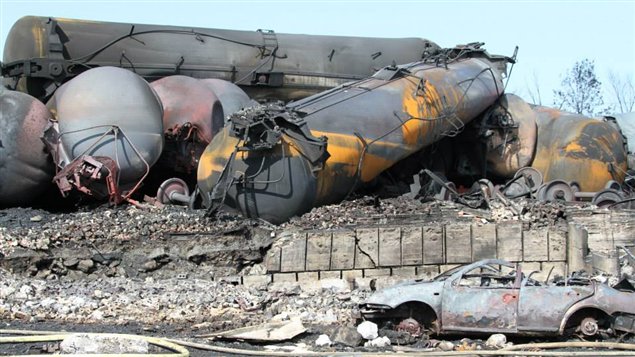While crude oil now enters Quebec on ships or through a pipeline, several companies are lining up to use more ships, a new pipeline and increasing numbers of trains to move crude from Western Canada to the eastern half of the country.
Instead of buying it from overseas countries, Quebec’s refineries would be processing oil from Western Canada and the United States, extracted through oilsands operations and hydraulic fracturing.
If all the proposed projects get the go-ahead, Quebec would experience a veritable oil boom.
The amount of oil entering the province on a daily basis would far exceed Quebec’s actual consumption and would be more than that carried by any of three controversial pipeline projects planned to move oil out of Western Canada, including the Keystone XL and Northern Gateway pipelines.
But in the wake of July’s devastating train derailment in Lac-Mégantic, moving oil by any mode of transport is coming under increasing scrutiny.
A Senate committee studying the transportation of petroleum products said Ottawa should review rail safety in Canada, given the “scope of the disaster” in Lac-Mégantic.
And while the National Energy Board is responsible for overseeing pipeline projects, Quebec has already promised to do its own consultation on a plan by Enbridge to carry oil from Ontario to Montreal East.
Dozens of environmental groups have called on Ottawa to set up an independent review of all modes of oil transportation across the country.
The majority of the increase in oil shipments into Quebec depends on the National Energy Board approving two pipeline projects — Enbridge’s Line 9B reversal project to Montreal East and TransCanada’s proposed Energy East pipeline, which would deliver crude oil to Montreal, Quebec City and Saint John, N.B. If approved, those two pipelines would carry nearly all — 1.4 million barrels per day — of the crude oil into Quebec by 2017.
But in a matter of days, trains carrying thousands of barrels of crude oil will begin arriving daily at the Valero Energy Corporation refinery in Lévis. By the end of next year, at least 60,000 barrels of oil per day are planned to be shipped by rail to Lévis and to Suncor Energy’s refinery in east-end Montreal. Suncor currently gets its crude oil via a pipeline that travels across southern Quebec and New England from Portland, Me.
But rail isn’t the only mode of transportation that could be carrying more oil in Quebec. While the Lévis refinery receives overseas crude oil from ships travelling through the Gulf of St. Lawrence and up the St. Lawrence River, Valero also hopes to ship North American crude arriving in Montreal on the Line 9B pipeline downriver to Lévis. This year, crude oil from Texas was transported by ship up the Eastern Seaboard of the U.S. to Lévis.
Quebec Environment Minister Yves-François Blanchet has already promised public consultations on Enbridge’s Line 9B pipeline project, although he said the type of consultation has not yet been chosen.
Environmental groups hope to hold the Parti Québécois to an election promise to reduce Quebec’s use of oil, and have been calling on Blanchet to release the details of the Line 9B consultation.
Blanchet told The Gazette that Quebec will conduct an in-depth review of the issues surrounding petroleum use, looking at economic, environmental, safety and transportation issues, as well as greenhouse gas emissions.
“There is no doubt that Quebec must free itself from petroleum use,” Blanchet said. “The question is knowing when will we be able to do that without causing economic hardship.”
Boosting Quebec’s oil flow
Within four years, Quebec could be awash in crude oil, with more than a million barrels criss-crossing the province every day.


























Laissez un commentaire Votre adresse courriel ne sera pas publiée.
Veuillez vous connecter afin de laisser un commentaire.
Aucun commentaire trouvé